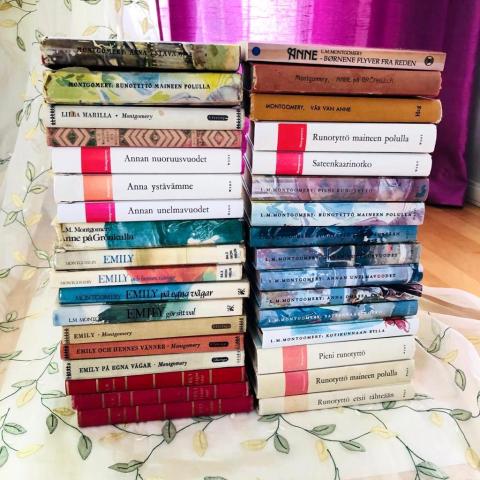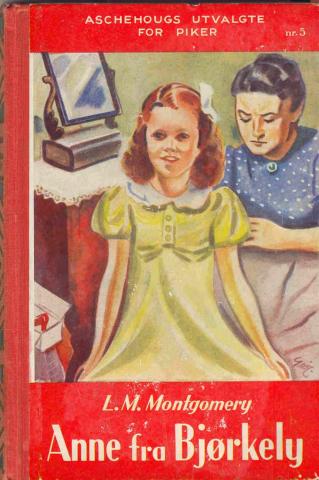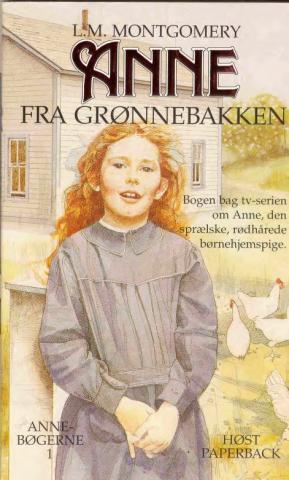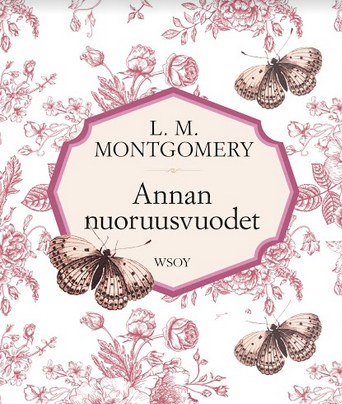Inspired by the conference theme “L.M. Montgomery and Vision” and my collection of Nordic editions of Montgomery’s books, I recently started an Instagram account called L.M. Montgomery Nordic @lmmontgomerynordic to share what I know about the Nordic book covers, other paratexts, and translations, which represent the Nordic publishers’ visions of Montgomery and her books. My collection started quite spontaneously about fifteen years ago because I discovered so many beautiful cover images and was further inspired by my Ph.D. research into the translations of Montgomery’s books.

My collection includes all the Nordic countries—Finland, Sweden, Norway, Denmark, and Iceland—because I feel at home in the whole Nordic region, which has a shared cultural heritage. Finland is my home country, but being a native speaker of both Finnish and Swedish and having studied Scandinavian languages at the Department of Scandinavian Languages and Literatures at the University of Helsinki, I can understand all the languages spoken in the Nordic region. Swedish, Norwegian, and Danish are very closely related and thus mutually understandable, while Icelandic has remained much closer to Old Norse than the other three Scandinavian or North Germanic languages, Iceland being an island in the middle of the Atlantic. Finnish is not a Scandinavian language at all but a Finno-Ugrian one, but my country still shares the Nordic cultural heritage because historically Finland was part of Sweden, and Swedish is still the second official language in Finland, spoken natively by about five percent of the population.
Alongside for example Japan, the Nordic region is one of the regions where Montgomery has reached the greatest international popularity. The number of translations and editions published is high, and many translations have remained in print continuously. There has also been significant research activity. In the last ten years that I have attended the L.M. Montgomery Institute’s International Conferences, I have met delegates from Finland, Sweden, and Iceland, and this year we would have had a delegate from Norway as well.
In the Nordic countries, Montgomery’s books were placed in the domain of children’s literature, which was a domain of the publishing industry that evolved after the Second World War. Research shows that there was extensive collaboration among publishers in the Nordic region in the early days of children’s literature publishing. For example, Päivi Heikkilä-Halttunen’s archival research shows that work at the first children’s literature department in Finland at the publisher WSOY [Werner Söderström Ltd] began with the children’s book editor making a trip to visit Swedish and Norwegian publishers to learn about their publishing strategies for children’s literature. My research shows that not only marketing strategies and the concept of publisher series were imported, but the Nordic publishers also based many of their translations of children’s books on translations into other Nordic languages rather than on the English originals. Therefore, it is not surprising that all early Nordic Montgomery translations are abridged, often in similar ways, and always for a younger audience than Montgomery’s original dual audience of young readers and adults. This has resulted in elements such as nature descriptions, spiritual qualities, intertextual references, and elements related to the female gender role being cut. Some of the cover illustrations reflect similar shifts in focus.
The following is a short introduction to the publishing history of Montgomery in each Nordic country, which shows that there are many translations and editions from different periods to discover.
Sweden
In 1909, only a year after the original publication of Anne of Green Gables, Sweden was the first country in the world to publish a translation. The Swedish translation Anne på Grönkulla [Anne on Green Hill] by Karin Lindforss Jensen was published by C.W.K. Gleerup. As Åsa Warnqvist has discovered, the initiative for publishing Anne of Green Gables in Sweden this early came from Seved Ribbing, one of the board members of the C.W.K. Gleerup publishing house, who may have discovered the book through a British advertisement or review. All the Anne books were translated into Swedish early on, and the Emily books followed in the 1950s, all in the publisher series Gleerups ungdomsböcker [Gleerup’s Juvenile Books]. Research shows that all the translations originally published by Gleerup are somewhat abridged due to targetting an audience of younger readers than Montgomery’s original dual audience. Sweden has also seen two highly abridged retranslations of Anne of Green Gables, one by Aslög Davidson in 1941 and another by Margareta Sjögren-Olsson in 1962, published by different publishers. These never reached the popularity of the original translation and its revised versions that have remained in print ever since the first publication. Montgomery’s continuous popularity in Sweden is evidenced by Warnqvist’s collection of and research on reading experiences. Sweden was also a forerunner in Montgomery scholarship, with a Ph.D. thesis by Gabriella Åhmansson already in 1991.

Norway
Norway also had an early translation of Anne of Green Gables in 1918 by the publisher Aschehoug with the title Anne fra Birkely [Anne from Birch Hill] translated by Elise Horn. This translation appears not to have been a success, since it was only reprinted once, and in 1941 Aschehoug published a new translation called Anne fra Bjørkely [Anne from Birch Hill] by Mimi Svedrup Lunden, which has remained in print. According to Susan Erdmann and Barbara Gawrońska Pettersson, Lunden’s translation is a highly abridged translation with a feminist and socialist agenda toning down Montgomery’s romantic and spiritual elements. All the Anne and Emily books published by Aschehoug appear to be similarly abridged. More recently, Norway has seen two unabridged retranslations of Anne of Green Gables, one by Venke Agnes Engh in 1982 and another by Kristina Quintano in 2014. The most recent one was published by Transit and more retranslations are planned.

Denmark
As in Norway, a translation of Anne of Green Gables was published in Denmark in 1918 by the publisher Aschehoug with the title Anna fra Grønnebrink [Anne from Green Hill] translated by Anna Erslev and Dagmar Gade. The early Danish translation has not been researched, but the fact that the Danish publisher was a branch of the Norwegian publisher points to some kind of collaboration. The Danish translation does not appear to have been a success either, and retranslation was not attempted until 1987 when the publisher Høst & Søn, encouraged by the popularity of the Anne of Green Gables miniseries by Sullivan Entertainment, published Anne of Green Gables with the title Anne fra Grønnebakken [Anne from Green Hill], translated by Gitte Nordbo. Høst & Søn went on to publish translations of the rest of the Anne and Emily books as well.

Finland
Finland followed with a translation of Anne of Green Gables in 1920. The translation called Annan nuoruusvuodet [Anna’s Juvenile Years] by Hilja Vesala was published by WSOY. The surprisingly generic Finnish title is very different from the titles used in the other Nordic countries, but the Finnish name for Green Gables is Vihervaara [Green Hill], making “hill” a recurring element in all the Nordic translations, despite that Montgomery’s original text never mentions Green Gables being situated on a hill. Several Finnish Master’s theses show that the early Finnish Anne translations were based on the Swedish translations. Further proof of translation via Swedish is that the publishing contracts for the first two Anne books mention the Swedish title as the source text. However, Finland was the first Nordic country to publish translations of the Emily books, beginning with I.K. Inha’s translation of Emily of New Moon published in 1928. In 1961, the Finnish Anne and Emily translations were revised and further abridged, presumably by WSOY’s children’s book editor Inka Makkonen, as Vappu Kannas has discovered, and the Swedish translations were used as models for all the revised books. The revised translations have remained in print, and Montgomery has been as continuously popular in Finland as in Sweden, which is documented by Suvi Ahola and Satu Koskimies in their collection of Finnish reading experiences. In recent years, the availability of Montgomery’s books in Finnish has increased thanks to Sisko Ylimartimo’s translations of all the previously untranslated Montgomery books published by Minerva. Montgomery’s books other than the Anne books, the Emily books, and Jane of Lantern Hill still remain untranslated in the other Nordic countries. Alongside Sweden, Finland was also a forerunner in Montgomery scholarship, with the first Ph.D. thesis on Montgomery by Vappu Kannas in 2015.

Iceland
Iceland was the last Nordic country to publish a translation of Anne of Green Gables in 1933 with the title Anna í Grænuhlíð [Anna in Green Hill], translated by Axel Guðmundsson and published by Ólafur Erlingsson. This translation was most likely based on the Danish translation, and this and other early Icelandic translations, which were reprinted several times, were abridged and simplified, according to a 2016 L.M. Montgomery Institute International Conference session by Sigríður Lára Sigurjónsdóttir, Ásta Gísladóttir, and Auður Aðalsteinsdóttir. They are the trio behind the initiative to publish unabridged retranslations of the Anne books translated by Sigurjónsdóttir. So far, four new translations have been published by the publisher Ástríki.

What There Is to Discover about Montgomery on Instagram
My Instagram account will be introducing the different Nordic editions of Montgomery’s books, but there is much more to discover about Montgomery on Instagram. Behind the hashtags of the book titles (original and translation titles, such as #anneofgreengables, #annepågrönkulla, #annefrabjørkely, #annefragrønnebakken, #annannuoruusvuodet, #annaígrænuhlíð), you can find covers of Montgomery’s books from around the world and readers’ stories about them. Apart from the Nordic countries, Poland (#aniazzielonegowzgorza) and other Eastern European countries, Spanish (#analadetejasverdes) and Portuguese (#annedegreengables) speaking countries, and Japan (#赤毛のアン) and other Asian countries are some other very active regions in the Montgomery community on Instagram.
Friendly communities always tend to develop around Montgomery. The community spirit is apparent both in the real-life research community centred on the L.M. Montgomery Institute International Conferences and in online Montgomery communities such as those on Instagram. Currently, much of the Montgomery activity on Instagram centres on the hashtag #LMMontgomeryMonday created by Trinna S. Frever. Using this hashtag, fans of Montgomery share Montgomery-related posts around weekly prompts. Another very visible project is Trinna S. Frever and Kate Scarth’s @yourlmmstory, and Montgomery often seems to pop up on #bookstagram in general.
You are welcome to join us!
Laura Leden, a Ph.D. candidate in Swedish Translation Studies at the University of Helsinki, Finland, is a regular participant at the LMMI biennial conference. With her expertise in girls studies, translation, and paratexts, as evidenced by a strong publication and conference record in children’s literature journals (for example, Barnboken–Journal of Children's Literature Research, 2019), collections (for example, Translating Boundaries: Constraints, Limits, Opportunities, Stuttgart, 2018), and venues (for example, the IRSCL conference in Stockholm, 2019), her contribution to Montgomery scholarship internationally is immense.
References and Further Reading About L.M. Montgomery in the Nordic Countries
Ahola, Suvi, and Satu Koskimies, editors. Uuden kuun ja Vihervaaran tytöt: Lucy M. Montgomeryn Runotyttö- ja Anna-kirjat suomalaisten naislukijoiden suosikkeina [The Girls of New Moon and Green Gables: The Emily and Anne books as the Favorites of Finnish Female Readers]. Tammi, 2005.
---. “Love and Controversy for Over Eighty Years: Anne, Emily, and Finnish Women: An Interview.” Storm and Dissonance: L.M. Montgomery and Conflict, edited by Jean Mitchell, Cambridge Scholars Publishing, 2008. pp 238–44.
Erdmann, Susan, and Barbara Gawrońska Pettersson. “Norwegian translations of Anne of Green Gables: Omissions and Textual Manipulations.” Languages—Cultures —Worldviews: Focus on Translation, edited by Adam Głaz, Palgrave Macmillan, 2020. pp. 349–366.
Heikkilä-Halttunen, Päivi. Kuokkavieraasta oman talon haltijaksi: Suomalaisen lasten- ja nuortenkirjallisuuden institutionalisoituminen ja kanonisoituminen 1940–1950-luvulla [From a Gatecrasher to the Owner of the House: The Institutionalization and Canonization of Finnish Children’s and Young Adult Literature in the 1940s to 1950s]. SKS Finnish Literature Society, 2000.
Kannas, Vappu. “Kuka lyhensi Runotytön? L. M. Montgomeryn Pieni runotyttö -kirjan käännöshistoriaa” [“Who abridged Emily? Translation History of L.M. Montgomery’s Emily of New Moon”]. Avain, vol. 4, 2014, pp. 48–61.
---. “‘Emily Equals Childhood and Youth and First Love’: Finnish Readers and L.M. Montgomery’s Anne and Emily Books.” Reading Today, edited by Heta Pyrhönen and Janna Kantola, UCL P, 2018. pp. 118–131.
Leden, Laura. “Emily Byrd Starr Conventionalized: Omissions of Nature Descriptions in the Swedish Translation of L.M. Montgomery’s Emily Trilogy.” The Looking Glass: New Perspectives on Children’s Literature, vol. 18, no. 2, 2015.
---. “L.M. Montgomery Censored? Canadian War Commentary in Rilla of Ingleside Adapted for Nordic Audiences.” The Lion and the Unicorn vol. 41, no. 2, 2017. pp. 143–66.
---. “For Children Only: Abridgement of Crossover Characteristics in the Finnish Translation of L.M. Montgomery’s Emily Trilogy.” Translating Boundaries: Constraints, Limits, Opportunities, edited by Stefanie Barschdorf and Dora Renna, Ibidem, 2018, pp. 121–143.
---. “Girls’ Classics and Constraints in Translation: A Case Study of Purifying Adaptation in the Swedish Translation of L.M. Montgomery’s Emily of New Moon.” Barnboken – Journal of Children’s Literature, vol. 42, 2019, pp. 1–22.
Rémi, Cornelia. “Interactions with Poetry: Metapoetic Games with Anne in Astrid Lindgren’s Madicken.” 100 Years of Anne with an “e”: The Centennial Study of Anne of Green Gables, edited by Holly Blackford, University of Calgary P, 2009, pp. 165–90.
---. “From Green Gables to Grönkulla: The Metamorphoses of Lucy Maud Montgomery’s Anne of Green Gables and Its Various Swedish Translations.” Barnboken – Journal of Children’s Literature, vol. 42, 2019, pp. 1–36.
Ross, Catherine Sheldrick, and Åsa Warnqvist. “Reading L.M. Montgomery: What Adult Swedish and Canadian Readers Told Us.” Journal of L.M. Montgomery Studies, 13 May 2020.
Sigurjónsdóttir, Sigríður Lára, Ásta Gísladóttir, and Auður Aðalsteinsdóttir. “Anne in Other Countries: Iceland”. Session at the L.M. Montgomery and Gender conference, 25 June 2016.
Warnqvist, Åsa, editor. Besläktade själar: Läsupplevelser av Anne på Grönkulla [Kindred Spirits: Reading Experiences of Anne of Green Gables]. BTJ, 2009.
---. “‘I Experienced a Light that Became Part of Me’: Reading Anne of Green Gables in Sweden.” Anne Around the World: L.M. Montgomery and Her Classic, edited by Jane Ledwell and Jean Mitchell, McGill-Queen’s UP, 2013, pp. 228–292.
---. “‘Don’t Be Too Upset with Your Unchivalrous Publisher’: Translator-Publisher Interactions in the Swedish Translations of L.M. Montgomery’s Anne and Emily Books.” Barnboken – Journal of Children’s Literature, vol. 42, 2019, pp. 1–37.
Back to top